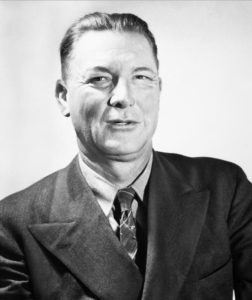
Erle Stanley Gardner was one of the well-known examples of a pulp writer who graduated to the slicks and the book market. He was a prolific writer who gave up his law practice to write full time. His first pulp magazine story was published in the June 1921 issue of Breezy Stories. He went on to publish in some of pulpdom’s greatest magazines: Black Mask, Top-Notch Magazine, Sunset, Fawcett’s Triple-X, Argosy, Flynn’s Detective Fiction, Clues, Ace High, Dime Detective, Double Detective… and the list goes on.
When it came to books, he wrote more than just Perry Mason, although those courtroom murder mysteries were perhaps his most famous. There were Bertha Cool and Donald Lam, Doug Selby, Ed Jenkins, Bob Larkin, Speed Dash, Paul Pry, Lester Leith, and I’m probably forgetting some more. He wrote so much that he started using pen names, to avoid watering down the demand for his work. He wrote the Cool and Lam books under the pen name A.A. Fair, for example. Some of his other pen names were Charles M. Green, Grant Holiday, Carleton Kendrake, Charles J. Kenny, Robert Park, Robert Parr, and Les Tillray.
But, today, I’m focusing on two of his Perry Mason books. I’m reviewing these in publication order, and we are up to #27 and #28 on his list of 85 Perry Maon books.
‘The Case of the Half-Wakened Wife’
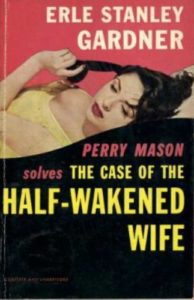
The gang’s all here for Perry Mason’s 27th outing, The Case of the Half-Wakened Wife published in September 1945. Perry, Della and Paul are here, as always. And Lieutenant Tragg and D.A. Hamilton Burger return in their familiar roles. Even switchboard operator Gertie and law clerk Jackson are included. It all makes for another wonderfully twisted murder mystery, the likes of which only Erle Stanley Gardner could tell.
Perry and Della are spending the night on the yacht of wealthy Parker Benton, along with a party of nearly a dozen others. But in the middle of the night, there is a murder. Perry stands on deck in the dark when there’s a scream, a gunshot, and spashes. And into his arms stumbles beautiful Marion Shelby, carrying a recently fired gun. When Scott Shelby, her husband, is found in the water dead from a gunshot wound, there’s little doubt what happened. But Perry must defend Marion Shelby anyway, and somehow prove her innocence.
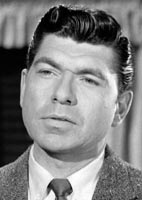
There’s the usual quota of courtroom action, here. And the usual vindictive give-and-take between counsel for the defense and the prosecution. Ya just gotta love it!
When CBS brought Perry Mason to televison with the wonderful Raymond Burr in the title role, they also adapted this book into a teleplay. It was aired in the second half of the first season, on March 15, 1958. They took a lot of liberties with the adaptation, and it was only a vague shadow of the book version. Still a darned good mystery, though.
Claude Akins — now there’s a guy who’s had so many roles on TV and in the movies that I just don’t know where to start — but anyway, he played Det. Sgt. Philip Dix in this episode.
‘The Case of the Borrowed Brunette’
A year after the publication of The Case of the Half-Wakened Wife it was time for another Perry Mason mystery. Perry, Della, and Paul are back for the 28th romp in the courtroom, courtesy of Erle Stanley Gardner. This time out, in the 1946 story The Case of the Borrowed Brunette, Lieutenant Tragg and Hamilton Burger are only mentioned, but don’t appear. Telephone operator Gertie is here; law clerk Jackson isn’t.
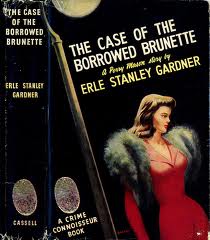
As Perry and Della drive down the city streets, they keep seeing the same woman on each street corner. Maybe not the exact same woman, but pretty darn close. She’s an attractive brunette, age 23 to 25, height five-feet-four-and-one-half inches, weight 111 pounds, waist measurement 24 inches, bust measurement 32, wearing a dark suit and a fluffy collar. After they see six of these women on six successive street corners, Perry has to stop to find out what’s going on. And that will lead him into one of the most complex and amazing mysteries of his career.
Plenty of courtroom action, here. And as usual, Perry is cutting some corners that will threaten to get him disbarred. But he manages to wriggle out of it at the end, and clear his two clients of a murder charge. The guilty party? I never saw it coming! That’s the sign of a good murder mystery.
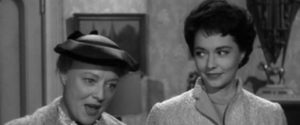
Apparently CBS television agreed. This story was brought to TV and aired on Jan. 10, 1959, as part of the Perry Mason second season. And this time around, they stuck closer to the plot of the book. I’m sure Erle Stanley Gardner was happy.
Erle Stanley Gardner was a world-class writer. These two books from the mid-1940s show him at the top of his craft. If you have watched the TV shows and have enjoyed them, you should give the books a try. As you read along, you’ll place the faces of Raymond Burr and Barbara Hale on the characters of Perry Mason and Della Street. I know I did. And there’s nothing wrong with that. The actors were excellent matches for the books’ characters.
Pick out a Perry Mason book — any one, it doesn’t matter which — and read it. You won’t regret it. There’s not a dud in the bunch, so pick one that sounds interesting to you. And hopefully my small reviews here will make that job easier. Perry Mason on TV was great… Perry Mason in the books was even greater. Trust me.
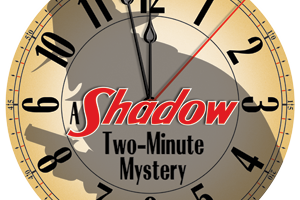
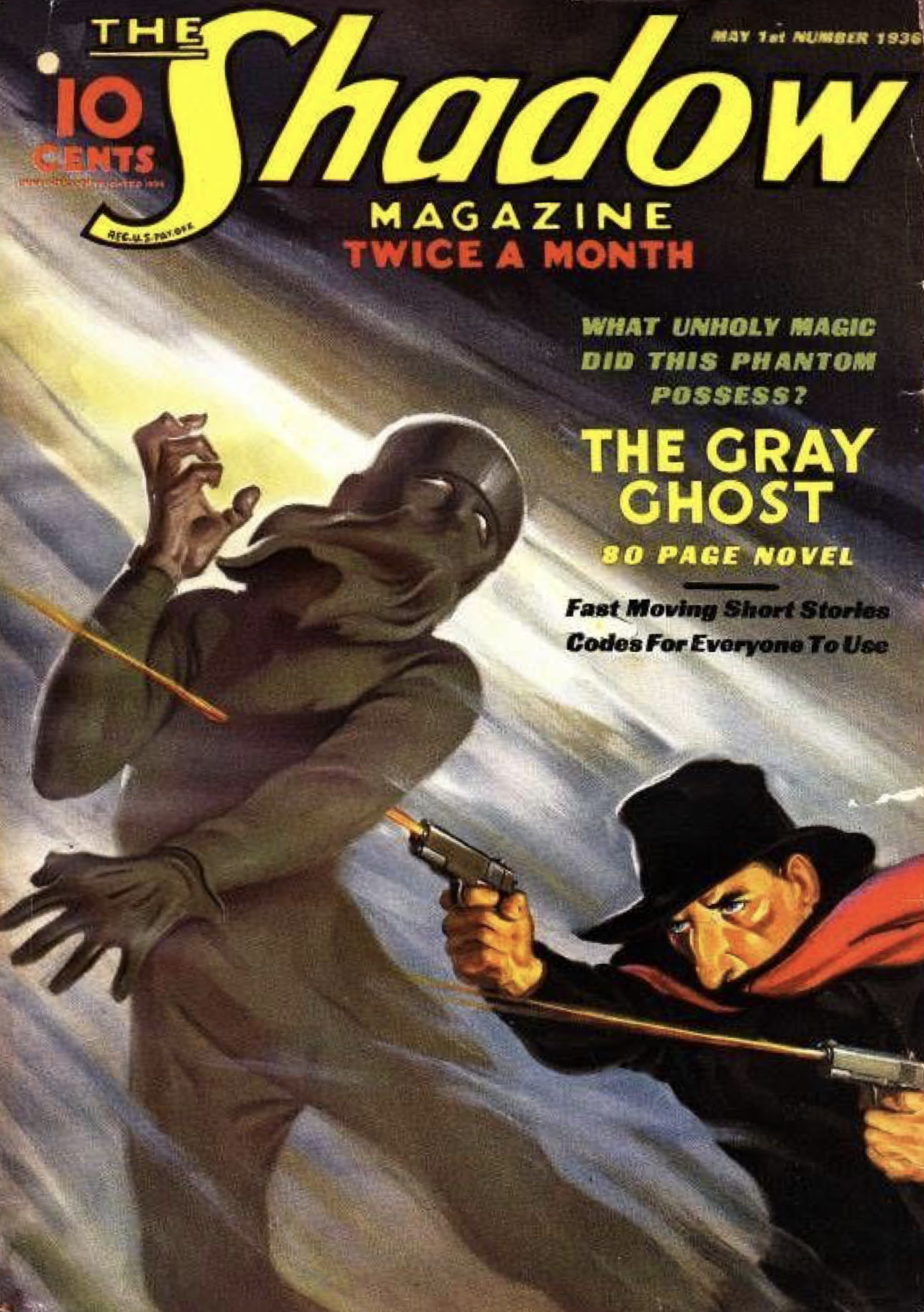
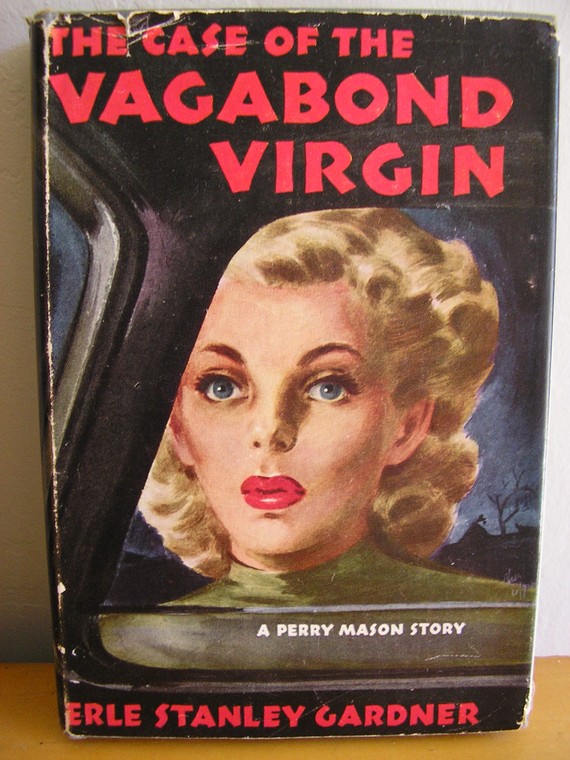
With these “That’s Pulp!” reviews of the Perry Mason novels on my mind, I read the Cool and Lam novel Top of the Heap ( Hard Case Crime edition, 2004; original copyright 1952 ) Although not a Perry Mason novel, Donald Lam is a disbarred attorney so a cousinhood connects the two characters. With a prolific writer like Gardner, the connectivity in his work was probably ideomotive, just spewing out as he typed, but his character of Donald Lam also presents in that prickly conflict between law and justice.
One does not have to stretch very far to suppose that the surname of Donald Lam came from the expression, “on the lam”. According to William Safire, the late “word maven” of the New York Times, etymologist J. E. Lighter traced the origin of “Lam” to the 18th century, providing as an example a passage from Allan Pinkerton’s 30 Years a Detective ( 1886 ) to illustrate its usage, “After ( the pickpocket ) secures the wallet, he will utter the word ‘lam!’ This means to let the man go and to get out of the way as soon as possible,” but as for the origin of the character’s name, Gardner might have been thinking of his other series character, Ed Jenkins who was on the lam from several states. By his very name, Donald Lam seems to have been created to defy the law as he sorts out justice while earning his fee.
While Lam and Jenkins, latter written under Gardner’s name and the former written under the pseudonym A. A. Fair, came from the same mind, Raymond Chandler feigned ignorance of that connection in his 19 December 1939 letter to George Harmon Coxe ( “…a book called The Bigger They Come by A. A. Fair which copies the Gardner technique exactly and even swiped Gardner’s idea of how Ed Jenkins couldn’t be extradited.” ) Chandler with a straight face loaded his work with sly similes and here he seems to be joshing Coxe in an equally deadpan manner. The mechanics of an author’s writing can be as distinctive as his fingerprints and Chandler had studied the mechanics of Gardner’s writing.
From his 5 May 1939 letter to Gardner himself, Chandler wrote, ” When we were talking about the old Action Detective magazine I forgot to tell you that I learned to write a novelette on one of yours about a man named Rex Kane, who was an alter ego of Ed Jenkins…. I simply made an extremely detailed synopsis of your story and from that rewrote it and compared what I had with yours, and then went back and rewrote it some more, and so on. It looked pretty good. Incidentally, I found out that the trickiest part of your technique was the ability to put over situations which verged on the implausible but which in the reading seemed quite real. I hope you understand that I mean this as a compliment. I have never come even near to doing it myself. Dumas had this quality in a very strong degree. Also Dickens. It’s probably the fundamental of all rapid work, because naturally rapid work has a large measure of improvisation an to make an improvised scene seem inevitable is quite a trick. At least I think so,” ( both letters from Selected Letters of Raymond Chandler, 1981, edited by Frank MacShane ).
Another Ed– the late novelist Ed Gorman, not the crook Ed Jenkins–said this on his blog Christmas day, 2006 ( newimprovedgorman.blogspot.com ), “I’ve never been able to figure out why Raymond Chandler felt he owed such a literary debt to Erle Stanley Gardner…. But what did he learn from Gardner? Certainly not style. Certainly not dialogue. Certainly not structure. Writers learn from unlikely sources, true enough. But Chandler seemed to lavish so much praise on Gardner you have to wonder what inspired him exactly.
“But Chandler was a snob and when you examine the nature of his praise, you get a sense he was being condescending. He said that only when you wrote at great speed ( as Gardner did ) could you make such unbelievable plot turns palatable to otherwise sensible readers. I’ve always wondered what Gardner made of that. He was no fool.”
I wonder the same thing about the reaction to Chandler’s fulsome-sounding praise to the third brethren of the Black Mask boys here, George Harmon Coxe. Before his small hoax about not knowing that Gardner and Fair are the same, Chandler wrote in his letter to Coxe, “If you still have that spare copy of your last book but one I’m hoping you are still feeling generous about it. The stock in the local library is all out anyway. You’re not represented. But so are not a lot of other people who should be, and so are represented some mighty feeble gestures at detective fiction. What do you make of a place that has one book by Hemingway, nothing by Faulkner, or Hammett,…,nothing by Coxe, Nebel, Whitfield, or anybody you would think of as at all representative” ( again Letters, 1981, MacShane ). I enjoyed Coxe’s Kent Murdock novel with his facile writing and descriptions of Boston and newspaper writing, two interests of mine, but to rank him to Raoul Whitfield or Frederick Nebel was not something I ever considered, never mind to Faulkner, Hemingway and Hammett.
To respond to Ed Gorman’s question, what did Gardner think about Chandler’s sincerity in his praise of Gardner’s work; permit me once to quote from another letter, this time to the editors of a magazine that they considered to be elite, again from Frank MacShane’s collection of Chandler’s letters, “(o)ne knows, roughly, what sort of people read the Post, Esquire, Terror Tales, New Republic, Mercury, and the grand old man of Arlington Street, the Atlantic,” ( 1 July 1937, to the editor of The Fortnightly Intruder. ) Was the calculated inclusion of Henry Steeger’s Terror Tales pulp magazine with its sadosexual covers Chandler’s way of saying that we should esteem each equally or was he saying that we should sneer at each group equally. The answer probably is that we should do both.
Erle Stanley Gardner was no fool and also had the advantage of having a first-hand insight into Chandler’s character. He probably understood that Chandler’s nature was to see the value of a story within its genre and to then turn arournd and demean the genre itself. He might have felt sorry for Chandler who instead of being satisfied with his success roiled with discontent.
As a coda to all this, glancing to a writer of renown outside of mystery fiction, we find Evelyn Waugh arbitrating between the merits of Erle Stanley Gardner and Raymond Chandler in an interview in the Paris Review, summer-fall 1963 issue. Interviewer Julian Jebb shoves forward the name of Raymond Chandler as if he had a poet among the barbarians. Waugh casts Chandler back among the barbarians and elevates Gardner as an amusing fellow.
Interviewer: Whom do you read for pleasure?
Waugh: Anthony Powell, Ronald Knox, both for pleasure and moral edification. Erle Stanley Gardner.
Interviewer: And Raymond Chandler!
Waugh: No. I’m bored by all those slugs of whiskey. I don’t care for all the violence either.
Interviewer: But isn’t there a lot of violence in Gardner?
Waugh: Not of the extraneous lubricious sort you find in other American crime writers,
And speaking of Cool and Lam, there’s a “lost” Cool and Lam mystery now available entitled “The Knife Slipped.” It was supposed to be the second novel in the series, but was rejected by the publisher. Rather than rewrite it, Gardner just tossed it aside and submitted “Turn On The Heat” the official second novel in the series.
Here I was, thinking I had read the entire series of 29 novels, when along comes a newly discovered 30th one! What a joy it was to read. I suppose it’s too much to hope that yet another lost one will surface. But I got a real kick out of “The Knife Slipped.”